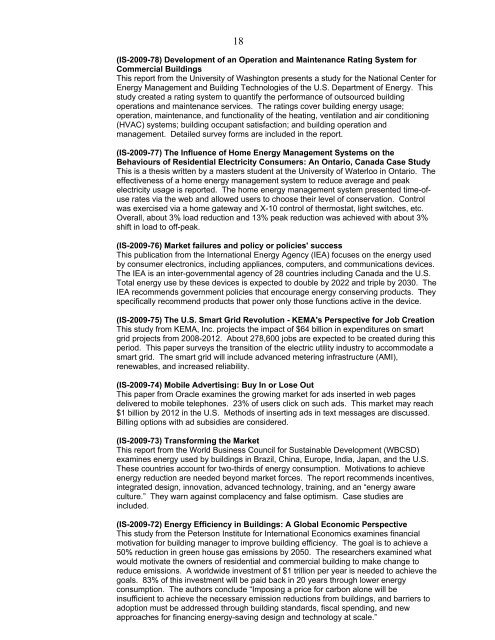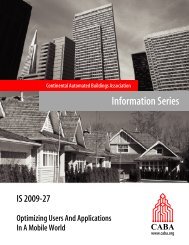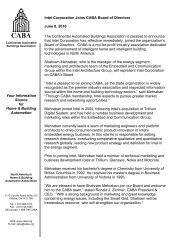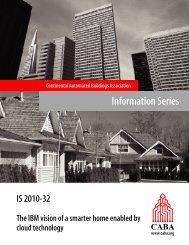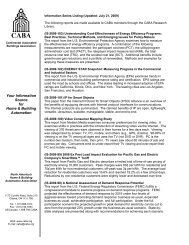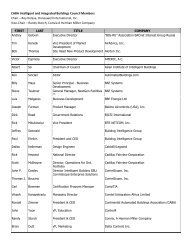Your Information Source for Home & Building Automation
Your Information Source for Home & Building Automation
Your Information Source for Home & Building Automation
Create successful ePaper yourself
Turn your PDF publications into a flip-book with our unique Google optimized e-Paper software.
18<br />
(IS-2009-78) Development of an Operation and Maintenance Rating System <strong>for</strong><br />
Commercial <strong>Building</strong>s<br />
This report from the University of Washington presents a study <strong>for</strong> the National Center <strong>for</strong><br />
Energy Management and <strong>Building</strong> Technologies of the U.S. Department of Energy. This<br />
study created a rating system to quantify the per<strong>for</strong>mance of outsourced building<br />
operations and maintenance services. The ratings cover building energy usage;<br />
operation, maintenance, and functionality of the heating, ventilation and air conditioning<br />
(HVAC) systems; building occupant satisfaction; and building operation and<br />
management. Detailed survey <strong>for</strong>ms are included in the report.<br />
(IS-2009-77) The Influence of <strong>Home</strong> Energy Management Systems on the<br />
Behaviours of Residential Electricity Consumers: An Ontario, Canada Case Study<br />
This is a thesis written by a masters student at the University of Waterloo in Ontario. The<br />
effectiveness of a home energy management system to reduce average and peak<br />
electricity usage is reported. The home energy management system presented time-ofuse<br />
rates via the web and allowed users to choose their level of conservation. Control<br />
was exercised via a home gateway and X-10 control of thermostat, light switches, etc.<br />
Overall, about 3% load reduction and 13% peak reduction was achieved with about 3%<br />
shift in load to off-peak.<br />
(IS-2009-76) Market failures and policy or policies' success<br />
This publication from the International Energy Agency (IEA) focuses on the energy used<br />
by consumer electronics, including appliances, computers, and communications devices.<br />
The IEA is an inter-governmental agency of 28 countries including Canada and the U.S.<br />
Total energy use by these devices is expected to double by 2022 and triple by 2030. The<br />
IEA recommends government policies that encourage energy conserving products. They<br />
specifically recommend products that power only those functions active in the device.<br />
(IS-2009-75) The U.S. Smart Grid Revolution - KEMA's Perspective <strong>for</strong> Job Creation<br />
This study from KEMA, Inc. projects the impact of $64 billion in expenditures on smart<br />
grid projects from 2008-2012. About 278,600 jobs are expected to be created during this<br />
period. This paper surveys the transition of the electric utility industry to accommodate a<br />
smart grid. The smart grid will include advanced metering infrastructure (AMI),<br />
renewables, and increased reliability.<br />
(IS-2009-74) Mobile Advertising: Buy In or Lose Out<br />
This paper from Oracle examines the growing market <strong>for</strong> ads inserted in web pages<br />
delivered to mobile telephones. 23% of users click on such ads. This market may reach<br />
$1 billion by 2012 in the U.S. Methods of inserting ads in text messages are discussed.<br />
Billing options with ad subsidies are considered.<br />
(IS-2009-73) Trans<strong>for</strong>ming the Market<br />
This report from the World Business Council <strong>for</strong> Sustainable Development (WBCSD)<br />
examines energy used by buildings in Brazil, China, Europe, India, Japan, and the U.S.<br />
These countries account <strong>for</strong> two-thirds of energy consumption. Motivations to achieve<br />
energy reduction are needed beyond market <strong>for</strong>ces. The report recommends incentives,<br />
integrated design, innovation, advanced technology, training, and an “energy aware<br />
culture.” They warn against complacency and false optimism. Case studies are<br />
included.<br />
(IS-2009-72) Energy Efficiency in <strong>Building</strong>s: A Global Economic Perspective<br />
This study from the Peterson Institute <strong>for</strong> International Economics examines financial<br />
motivation <strong>for</strong> building manager to improve building efficiency. The goal is to achieve a<br />
50% reduction in green house gas emissions by 2050. The researchers examined what<br />
would motivate the owners of residential and commercial building to make change to<br />
reduce emissions. A worldwide investment of $1 trillion per year is needed to achieve the<br />
goals. 83% of this investment will be paid back in 20 years through lower energy<br />
consumption. The authors conclude “Imposing a price <strong>for</strong> carbon alone will be<br />
insufficient to achieve the necessary emission reductions from buildings, and barriers to<br />
adoption must be addressed through building standards, fiscal spending, and new<br />
approaches <strong>for</strong> financing energy-saving design and technology at scale.”


